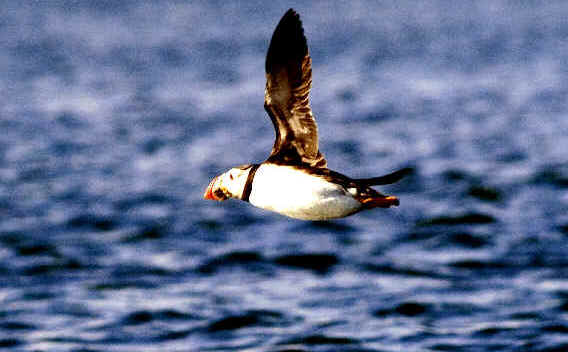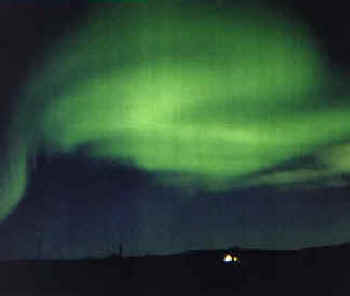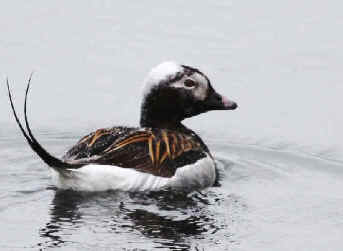
E-mail: font@focusonnature.com
Phone: Toll-free in USA 1-888-721-3555
or 302/529-1876
 |
PO
Box 9021, Wilmington, DE 19809, USA E-mail: font@focusonnature.com Phone: Toll-free in USA 1-888-721-3555 or 302/529-1876 |
 Iceland
Birds
Iceland
Birds
during
Focus On Nature Tours
1996 thru 2015
during the
months of
May, June,
September, October
The following list compiled by Armas Hill
Photo at right: An ATLANTIC PUFFIN in flight, photographed in Iceland.
Puffins abound in Iceland during FONT tours in May & June.
There have been 20 FONT
tours in Iceland, during which 115 species of birds have cumulatively been
found.
Codes:
(nt): a near-threatened species
globally, designated by Birdlife International
(ICpm): a passage migrant in Iceland
(ICr): rare in Iceland
(ICv): a vagrant in Iceland
(ICwv): has generally considered a winter visitor in Iceland
(i): an introduced species
(ph): species with a photo in the FONT website
Links:
A Complete List of Birds in Iceland
(387 species, including vagrants from mainland Europe, Asia, & North
America)
A List & Photo Gallery of European
Birds, in 2 Parts:
Part 1: Grouse to Puffin
Part 2: Sandgrouse to Buntings
Upcoming FONT Birding & Nature Tours in Iceland Past FONT Tour Highlights
Directory of Photos in this Website

![]()

The Long-tailed Duck is an
Icelandic breeder.
This male was photographed during
the FONT Iceland Tour in June 2015.
(photograph by Marie
Gardner)
Bird-List:
![]()
Data regarding some Icelandic Birds
(found during FONT tours):
RED-THROATED LOON (or RED-THROATED DIVER)
breeding pairs: 1,000-2,000
wintering birds: 100-1,000, mostly southwest
GREAT NORTHERN LOON (or COMMON LOON , or GREAT NORTHERN DIVER)
breeding pairs: 300 (the only European breeders)
wintering birds: 100-1,000, along all coasts
some winter on waters off British Isles & mainland western EuropeHORNED GREBE (or SLAVONIAN GREBE)
breeding pairs: 300-500
wintering birds: 10-50, mostly southwest
NORTHERN FULMAR
breeding pairs: 2 million or more
MANX SHEARWATER
breeding pairs: 8,000-10,000 |
EUROPEAN STORM-PETREL
breeding pairs: 100,000
LEACH'S STORM-PETREL
breeding pairs: 80,000-150,000
NORTHERN GANNET
breeding pairs: 25,000
in winter south to coasts of western Europe & northwestern Africa
GREAT CORMORANT
breeding pairs: 3,200
wintering birds: 10,000-20,000EUROPEAN SHAG
breeding pairs: 7,000
wintering birds: 30,000-40,000
mostly in western Iceland
GREY HERON
mostly a winter visitor, mostly immature birds
from NorwayWHOOPER SWAN
breeding pairs: 2,500
wintering birds: 1,000
most in winter to IrelandPINK-FOOTED GOOSE
breeding pairs: 25,000 (in the interior highlands)
in winter to Britain, BelgiumGREATER WHITE-FRONTED GOOSE
to/from W Greenland
in passage in SW Iceland: 30,000 birds
in winter to IrelandGREYLAG GOOSE
breeding pairs: 10,000-20,000
wintering birds: 500-550
most in winter to Ireland, Scotland
BARNACLE GOOSE
to/from NE Greenland
in passage in southern Iceland: 35,000 birds
in winter to British IslesBRANT GOOSE (the light-bellied subspecies)
to/from northern Canada, northern Greenland
in winter to Ireland, EnglandEURASIAN WIGEON
breeding pairs: 4,000-6,000
wintering birds: 500-2,000, mostly southwest
majority of Iceland breeding population winters in British IslesGADWALL
breeding pairs: 200-300
wintering birds: very few
most in winter to Ireland
NORTHERN PINTAIL
breeding pairs: less than 500EURASIAN TEAL
breeding pairs: 5,000-8,000
wintering birds: 100-500, mostly southwest
most in winter to England, Ireland, Denmark thru SpainMALLARD
breeding pairs: 10,000-15,000
wintering birds: 20,000-40,000TUFTED DUCK
breeding pairs: 5,000-8,000
wintering birds: 100-200GREATER SCAUP
breeding pairs: 3,000-5,000
wintering birds: 50-150
BLACK SCOTER (has also been called COMMON SCOTER)
breeding pairs: 400-600
in Iceland occurs almost exclusively at Lake Myvatn, where it breeds
in winter at sea off western Europe & south to the Azores
a few winter in NE IcelandCOMMON EIDER
breeding pairs: 300,000
wintering birds: 1,000,000
birds from E Greenland winter & moult in Iceland waters
KING EIDER
rare in Iceland; some visit from Greenland & SvalbardHARLEQUIN DUCK
breeding pairs: 2,000-3,000
wintering birds: 14,000
the only European populationLONG-TAILED DUCK
breeding pairs: 3,000-5,000
wintering birds: 10,000-100,000, many from Greenland
BARROW'S GOLDENEYE (In Europe, breeds only in Iceland)
breeding pairs: 400-800
wintering birds: 1,600
localized
the only population in Europe, non-migratory
RED-BREASTED MERGANSER
breeding pairs: just under 4,000
wintering birds: 5,000-15,000COMMON MERGANSER (or GOOSANDER)
breeding pairs: less than 300
wintering birds: 500-1,500WHITE-TAILED EAGLE
breeding pairs: 65
wintering birds: 120-150
mostly in western IcelandMERLIN
breeding pairs: 500-1,000
wintering birds: 10-100GYRFALCON
breeding pairs: 300-400
wintering birds: 1,000-2,000
resident: population fluctuates as does its prey, the Ptarmigan
in winter also preys on ducks along the coastROCK PTARMIGAN
breeding pairs: 50,000-200,000 (years vary)
wintering birds: up to 1,000,000 (years can vary)EURASIAN OYSTERCATCHER
breeding pairs: 10,000-20,000
wintering birds: 2,000-3,000EUROPEAN GOLDEN PLOVER
breeding pairs: 200,000-300,000
in winter to western continental Europe
COMMON RINGED PLOVER
breeding pairs: 30,000-50,000
in winter to southwest Europe & western AfricaPURPLE SANDPIPER
breeding pairs: 20,000-30,000
wintering birds: 10,000-100,000RUDDY TURNSTONE
Wintering birds: 2,000-5,000, from northern + eastern Greenland
others in passage: 40,000 birds in the springDUNLIN
breeding pairs: 200,00-300,000SNIPE
breeding pairs: 300,000-plus
wintering birds: 100-plus
"EURASIAN" WHIMBREL
breeding pairs: 100,000-200,000EURASIAN CURLEW
wintering birds: 50-100, from Norway
BLACK-TAILED GODWIT
breeding pairs: 10,000
in winter mostly in Ireland, also southwest Europe
BAR-TAILED GODWIT
annual winter visitor in small numbers along southwest coast
breeds in northern Scandinavia and east in SiberiaCOMMON REDSHANK
breeding pairs: 50,000-100,000
wintering birds: 500-1,000
RED-NECKED PHALAROPE
breeding pairs: 30,000-40,000
RED PHALAROPE (has has been called GREY PHALAROPE)
breeding pairs: 190 (in summer of 2004)
one of the last Icelandic breeders to arrive in the spring
GREAT SKUA
Breeding pairs: 5,400
about 75 per cent of the global population
one of the first migrants to arrive in the spring, in March
PARASITIC JAEGER (or ARCTIC SKUA)
Breeding pairs: just under 10,000
both light & dark morphs are common in Iceland
in winter to Southern HemisphereICELAND GULL
wintering birds: 5,000-10,000, from GreenlandGLAUCOUS GULL
breeding pairs: 10,000-15,000
wintering birds: 30,000-50,000COMMON BLACK-HEADED GULL
breeding pairs; 25,000-35,000
wintering birds: 3,000-10,000MEW (or COMMON) GULL
breeding pairs: 300-400
wintering birds: 100-200"EUROPEAN" HERRING GULL
breeding pairs: 15,000-20,000
wintering birds: 15,000-25,000GREAT BLACK-BACKED GULL
breeding pairs: 15,000-30,000
wintering birds: 50,000-80,000
LESSER BLACK-BACKED GULL
breeding pairs: 25,000-35,000
started to breed in Iceland in the 1920's
in winter to Iberian Peninsula & northwest AfricaBLACK-LEGGED KITTIWAKE
breeding pairs: 630,000
wintering birds: 10,000-1,000,000
ARCTIC TERN
breeding pairs: 200,000-300,000
in winter to oceans off South Africa east to AustraliaCOMMON MURRE (or GUILLEMOT)
breeding pairs: 990,000
wintering birds: 4 to 5 million
THICK-BILLED MURRE (or BRUNNICH'S GUILLEMOT)
breeding pairs: 580,000RAZORBILL
breeding pairs: 380,000
wintering birds: 300,000-600,000BLACK GUILLEMOT
breeding pairs: just under 20,000
wintering birds: 50,000-100,000
ATLANTIC PUFFIN
breeding pairs: just under 3 million
Iceland has the largest population of Atlantic Puffins
LITTLE AUK (or DOVEKIE)
observed fairly frequently in the winter
formerly bred in northern Iceland (most recently on Grimsey Island)
SHORT-EARED OWL
breeding pairs: 100-200
occurs sparsely throughout Iceland, mostly in the north
in winter to western mainland Europe
BARN SWALLOW
has bred uncommonly in IcelandMEADOW PIPIT
breeding pairs: 500,000-1 million
in winter to Spain, western France
WHITE WAGTAIL
Breeding pairs: 20,000-50,000
in winter to western Africa"ICELANDIC WREN" (a subspecies of the NORTHERN, or WINTER, WREN)
breeding pairs: 2,000-5,000
wintering birds: 3,000-10,000NORTHERN WHEATEAR
breeding pairs: 20,000-50,000
birds that breed in Greenland occur in Iceland in the spring & fall
in winter to western AfricaREDWING
breeding pairs: 100,000-300,000
wintering birds: 1,000-5,000
most in winter to England, Ireland, France, SpainNORTHERN RAVEN
breeding pairs: 2,500
wintering birds: 10,000-13,000COMMON STARLING
breeding pairs: 3,000
wintering birds: 5,000-15,000
recently established, first bred in Iceland in 1940's, first in Reykjavik in 1960's
has been spreading gradually throughout IcelandCOMMON REDPOLL
breeding pairs: 2,000-20,000
wintering birds: 20,000-100,000
SNOW BUNTING
breeding pairs: 50,000-100,000
wintering birds: 100,000-300,000
some in winter from Greenland (+ north)
some Iceland breeders in winter to Scotland